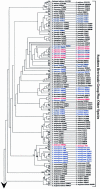A single domestication for potato based on multilocus amplified fragment length polymorphism genotyping
- PMID: 16203994
- PMCID: PMC1253605
- DOI: 10.1073/pnas.0507400102
A single domestication for potato based on multilocus amplified fragment length polymorphism genotyping
Abstract
The cultivated potato, Solanum tuberosum, ultimately traces its origin to Andean and Chilean landraces developed by pre-Colombian cultivators. These Andean landraces exhibit tremendous morphological and genetic diversity, and are distributed throughout the Andes, from western Venezuela to northern Argentina, and in southern Chile. The wild species progenitors of these landraces have long been in dispute, but all hypotheses center on a group of approximately 20 morphologically very similar tuber-bearing (Solanum section Petota) wild taxa referred to as the S. brevicaule complex, distributed from central Peru to northern Argentina. We present phylogenetic analyses based on the representative cladistic diversity of 362 individual wild (261) and landrace (98) members of potato (all tuber-bearing) and three outgroup non-tuber-bearing members of Solanum section Etuberosum, genotyped with 438 robust amplified fragment length polymorphisms. Our analyses are consistent with a hypothesis of a "northern" (Peru) and "southern" (Bolivia and Argentina) cladistic split for members of the S. brevicaule complex, and with the need for considerable reduction of species in the complex. In contrast to all prior hypotheses, our data support a monophyletic origin of the landrace cultivars from the northern component of this complex in Peru, rather than from multiple independent origins from various northern and southern members.
Figures


References
-
- de Candolle, A. (1959) Origin of Crop Plants (reprint of 1886 version) (Hafner Publishing Company, New York).
-
- Sauer, C. O. (1969) Agricultural Origins and Dispersals (MIT Press, Cambridge, MA).
-
- Hawkes, J. G. (1983) The Diversity of Crop Plants (Harvard Univ. Press, Cambridge, MA).
-
- Harlan, J. R. (1992) Crops and Man (ASA/CSSA/SSA, Madison, WI), 2nd Ed.
-
- Zohary, D. & Hopf, M. (2000) Domestication of Plants in the Old World (Oxford Univ. Press, Oxford), 3rd Ed.
Publication types
MeSH terms
LinkOut - more resources
Full Text Sources
Other Literature Sources

